Texas Railroad History - Tower 146 - Edcouch
A Crossing of the Southern Pacific and Missouri Pacific
railroads in the Rio Grande Valley
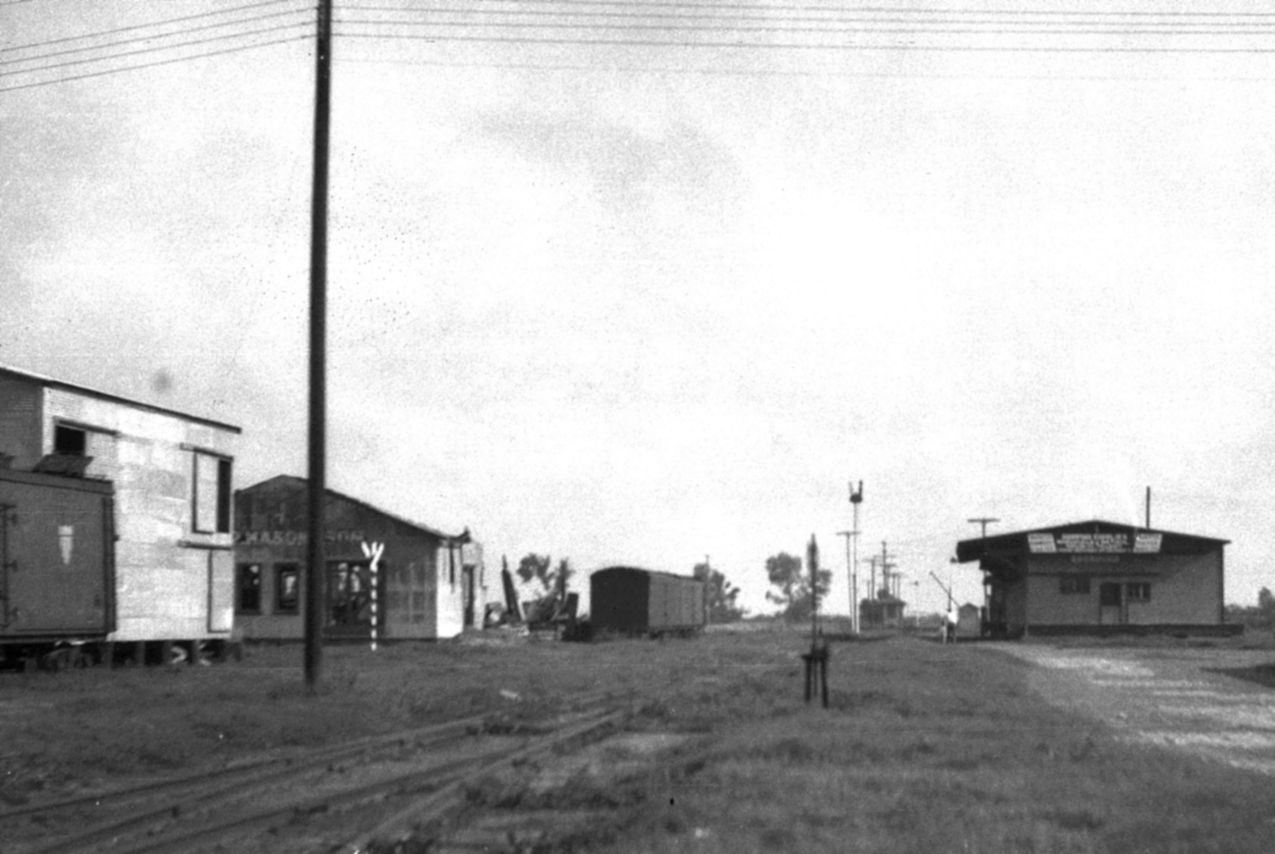
Above: Sometime in the 1930s or early 1940s, John W. Barriger III took this
photo while visiting the Rio Grande Valley of Texas. The photo was almost certainly taken in Edcouch,
based on the following evidence. First, the cabin visible in the distance
matches the scene and appearance of the only confirmed photo of Tower 146
(below) that has been
obtained. Second, based on other photos in Barriger's sequence, he was known to
be in the Rio Grande Valley, but this scene does not match any of the other
cabin interlockers in that area. The position of the tracks and the semaphore
signals with respect to the cabin is consistent with a north view
along the Missouri Pacific (MP) tracks in Edcouch. Barriger's private car was
pulled by an MP train, so he is likely stopped at the depot south of the
crossing and has left his private car to take the photo as he is clearly not on the
tracks.
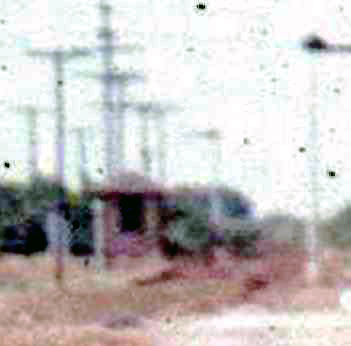

Above Left: This is a magnification of the photo
above right, but it's the best confirmed image
we have of the Tower 146 cabin interlocker in Edcouch. Two semaphores are visible which
guarded the Southern Pacific (SP) line
immediately south
of the cabin. The normal position for the semaphores
was down for the
MP line and up for the SP line. Above
Right:
Seen in this photo is the depot and tin-covered freight house with the
"EDCOUCH" sign and the familiar MP brown-and-cream painted doors. The Tower 146
cabin is visible in the distance, as is the 1958 black and white Ford of the station agent,
Mr. Rufus Milligan. This would date the photo to between 1958 and 1968,
when the MP line was abandoned. The view is from the southwest corner of
the freight house looking along the east side of MP's main track to the
north. (photos and captions provided by Bill Bentsen)
In 1904, the San Antonio & Aransas Pass (SA&AP)
railroad sought to extend its rails to the Rio Grande Valley of Texas. The
impetus likely came from SA&AP's previous owner Southern Pacific (SP) wishing to
compete with a new rail line to the Valley being built by the St. Louis,
Brownsville & Mexico (SLB&M) Railway. The SA&AP was divested from SP ownership
by court order in 1903, but SA&AP proceeded with plans to build to the Valley
from their nearest service point, the town of Alice. In 1904, the first 36 miles
was completed from Alice south to Falfurrias. The Valley was less than 80 miles
away, but construction stopped and was not restarted until the SA&AP was
re-acquired by SP in 1925. SP's main line to the Valley was completed in 1927
from San Antonio to McAllen, passing through Skidmore, Alice and Falfurrias
among many other south Texas towns. Also that year, a 63-mile branch line from
Edinburg to Brownsville was built. These lines provided SP with traffic from a
vast area of agriculture and expanding population.
The Valley was already served by the Missouri Pacific (MP) railroad which
had acquired the SLB&M in 1925. MP constructed branch lines into the area around
Edinburg in 1926, and a year later, SP's branch line to Brownsville crossed the
MP at Edcouch, a new town named for....Ed Couch! Ed was a local banker and
landowner (and, apparently, a self-promoter!) who foresaw the advantage of
having a town midway between
Edinburg and Harlingen served by two railroads.
Unfortunately for Ed, the town never really prospered despite the railroad crossing.
A cabin interlocker
protecting the SLB&M/SA&AP crossing was approved for operation by the Railroad
Commission of Texas (RCT) on February 5, 1929, identified as Tower 146. RCT's
annual list of interlockers first mentions Tower 146 as "Under Constr." in a
table published December 31, 1928, a few weeks before it was commissioned. RCT
listed the location of Tower 146 as "Ed Couch". The list published at the end of
1929 gave the final commissioning date and described the interlocker as a
mechanical cabin with eleven functions, still identified as being at "Ed Couch".
This spelling was
retained on RCT's final comprehensive list published at the end of 1930.
Consistent with RCT's policy, the subsidiary companies were listed
as the two railroads protected by the interlocker rather than listing the parent
companies MP and SP. The SA&AP ceased to exist in
1934 when it was merged into the Texas & New Orleans (T&NO) Railroad, SP's
primary operating company for Texas and Louisiana. The SLB&M officially
disappeared when it was merged into MP in 1956.

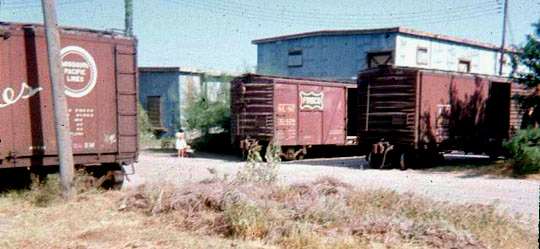
Above Left:
This is the original, unedited photo showing the cotton gin across the
tracks. Above Right: An additional photo
taken at the same time is a view of three boxcars waiting to be loaded.
Note that the Frisco boxcar has wood sides and all three have friction
bearings. This was a typical view of an old south Texas town in
the 50s, full of dust and grime and
very, very tired. There is
a gravel road crossing with a couple of kids seen
next to a
packing house. When the train came to pick up these
cars, the track would creak and groan under
the weight, and the
wheels would crush the gravel and weeds which accumulated over
the railheads.
An old Missouri Pacific GP7 with faded blue and
white colors would huff and belch smoke, and the
train crew would
open the interlocker to set the way for their return to Monte
Alto, Hargill and
Raymondville. (photos and captions provided by Bill Bentsen)
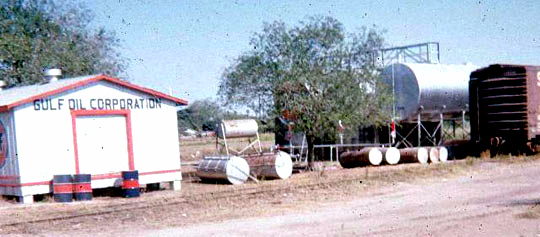
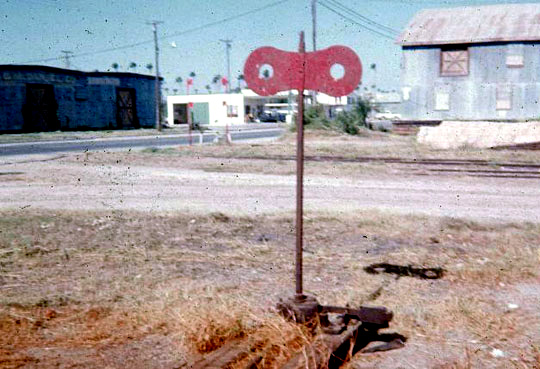
Above Left:
This view is of a Gulf Oil Corporation facility of some sort.
The boxcar is probably just
spotted there for storage. Note that
the track is almost buried in the sand and gravel
which comprised
most of these hot little towns in the Valley. Above
Right: An old, faded switch stands in the heat of the setting sun (shadow shown on
the east side
of the marker). The sun has even parched the weeds during this
hot, dry summer. My grandfather
had a chemical business in an old railroad building just to the
right of this switch stand. It was a
typical tin-covered affair
with MP brown-and-cream doors and peeling paint. (photos and captions
provided by Bill Bentsen)
Observations by Bill Bentsen:
My grandparents lived in Edcouch in the lower Rio Grande
Valley, at the crossing of the MP (SLB&M) and
the SP (SA&AP), site of Tower 146.
The SLB&M line was a north-south line, while
the SA&AP line was east-west, and the lines crossed
at a 90-degree diamond. The interlocker was a cabin-type where the train crews
operated the controls. The cabin, located at the northwest corner of the
crossing, was approximately 15 feet square and was on short stilts
to ensure that any flooding from tropical hurricanes would not damage the interlocking
plant
or building. The construction was entirely of wood with
clapboard siding, and the roof was asphalt-type shingles, probably
black. There were double-hung windows across
the south side (SP side) and east side (MP side) to
assure a good view of the crossing. The cabin was painted
white at one time, but the effects of time and weather had pretty
much rendered the paint job dull gray by the time I was observing
it. There were two signs on the interlocker, one on the MP side
and one on the SP side. The signs read simply "146". The entry to the interlocker was from the MP side via a short stairway with
wood handrails that led to a wood door. The stairway was accessed over
a very short wood sidewalk/bridge which crossed the ROW drainage
ditch alongside the MP track. There were Armstrong-type
handles inside which controlled the semaphores and the derails
via standard interlocking pipes and rollers. The pipes that controlled
the SP line ran along the north side of the SP track, while the
pipes that controlled the MP track ran along the west side of
the MP track. The interlocker was the most simple type as it was only used
to protect the routing by setting the semaphores and derails properly.
The SP line (which was used substantially more) had a clear indication
with the semaphores in the upright position and the derails closed
while the MP line was always set in the stop or semaphore down
position with the derails open. I do not recall that the semaphores
were lighted; however, they well may have been.
The interlocker was used only by the MP crew. As I recall,
when the train arrived from Raymondville via Hargill and Monte
Alto (southward), it would stop at the closed semaphore and wait
until the brakeman went to the interlocker. He opened a standard
railroad switch lock which protected the building, then he moved
the Armstrong levers until the MP line was cleared over the SP
line. The mechanism changed the semaphores and derails appropriately.
Once this maneuver was accomplished, the MP train would
cross the SP line in complete safety as intended. The signal apparatus
was left in this position until after the switching was completed
and the train crossed back northward. Once it cleared the crossing
and the caboose was completely past the north signal, the brakeman
reversed the setup and again set the signals for the SP line.
He then locked up the cabin and boarded the caboose to leave town.
The location of the original SA&AP Edcouch depot was
on the northeast corner of the diamond. I never saw the depot
as it was removed long before my knowledge of the area; however,
the foundation remained as witness to the depot's existence. Passenger
service on the SP ended shortly after WWII according to my mother,
and the depot was razed shortly after that. The MP station was southeast of the diamond, and was a wooden
building with a freight house attached. It was painted the standard
MP brown and cream and it had a bay window facing the track. Interestingly,
MP never offered passenger service on this line, but the freight
agent at the station could issue passenger tickets. MP passenger
service was available on the mainline from Harlingen to Houston,
and the closest passenger station to Edcouch was at Raymondville.
This was where we always boarded the train when we went home to
Dallas after visiting my grandparents. The station was severely
damaged by a hurricane in the mid-60s, and the railroad elected
to abandon it rather than repair it. The agent retired simultaneously.
MP abandoned the Edcouch to Weslaco 7.56-mile line in 1961,
and then abandoned the Monte Alto to Edcouch line in 1968. This, of
course, was the end of the need for the interlocker, which was
abandoned in 1968 also. The SP line continued to operate under SP ownership
until the merger with Union Pacific (UP). In 1999, UP filed to abandon the
"Santa Rosa Industrial Lead" between Edinburg and Rogerslacy, and the final
rails were removed from Edcouch in 2000.
[Not to be outdone by Ed Couch, Rogerslacy was named
for... Rogers Lacy!]
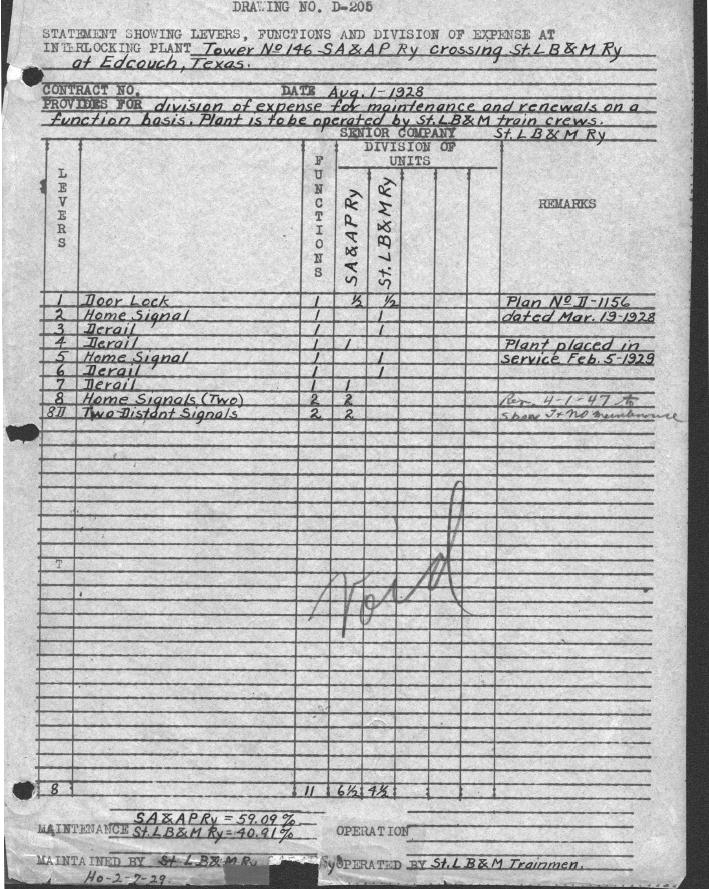 |
Left:
SP used an internal form known as a "D-205" to document interlocker
functions for purposes of determining how expenses would be shared with
participating railroads. This one for Tower 146 was drafted on August 1,
1928 based on an interlocking plant design dated March 19, 1928. The
document notes that SLB&M is responsible for maintenance, and that
SLB&M's train crews will operate the interlocker, i.e. the signals will
always be lined to allow SA&AP trains to pass
unless an SLB&M train is actively using the crossing (which makes
SLB&M crews responsible for re-lining the signals after crossing so that
SA&AP trains have a clear signal.) The REMARKS column confirms RCT
records that the plant was placed in service on February 5, 1929.
Another notation states that as of April 1, 1947, T&NO (SP) train crews
took over maintenance responsibility.
Subsequent iterations of
this document show that the design plan was revised on January 21, 1949
to reflect removal of the derails on SP's tracks. The next revision was
made on April 1, 1952 to add two signals of unspecified functionality.
This caused the agreed expense allocation to become 50/50. Two later
revisions are documented, beginning on February 1, 1955 for "...account
inoperative approach signals on the St.LB&M Ry." The final revision was
made on September 1, 1959 for "...account T&NO spur track removed from
interlocker." This final version also notes "Out of service Sept. 17,
1968". (Carl Codney collection) |
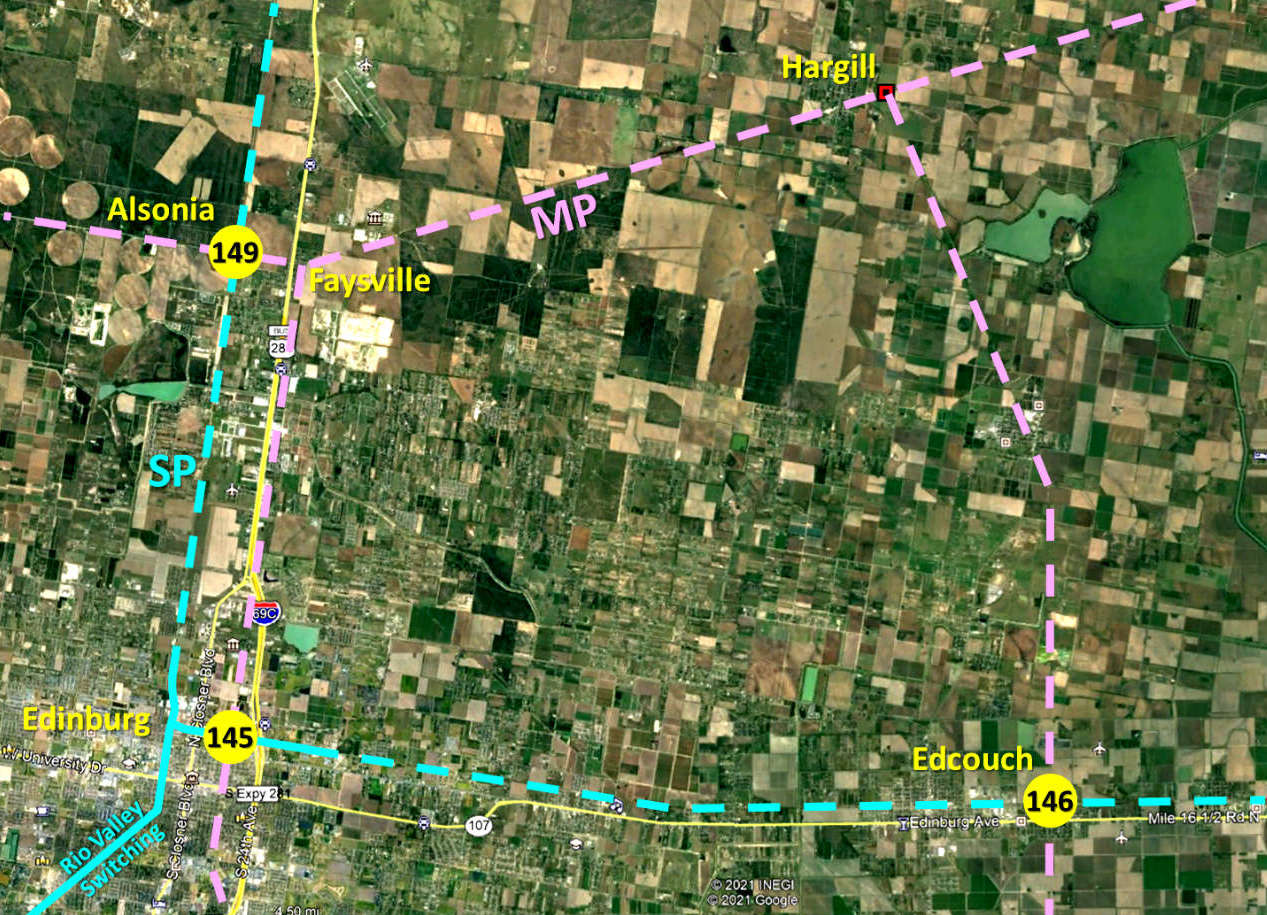
Above:
(With SP in blue and MP in pink) SP's main line from Falfurrias came in at the top of the map, crossed the MP
at Tower 149, and continued south through Edinburg
to McAllen. SP's branch to Harlingen crossed existing MP tracks in Edinburg (Tower
145) and Edcouch. All of these track segments have been abandoned except a
short segment of the former SP line west of Tower 145 and a branch coming north
on the former SP line from McAllen to Edinburg operated by the Rio Valley
Switching Co.
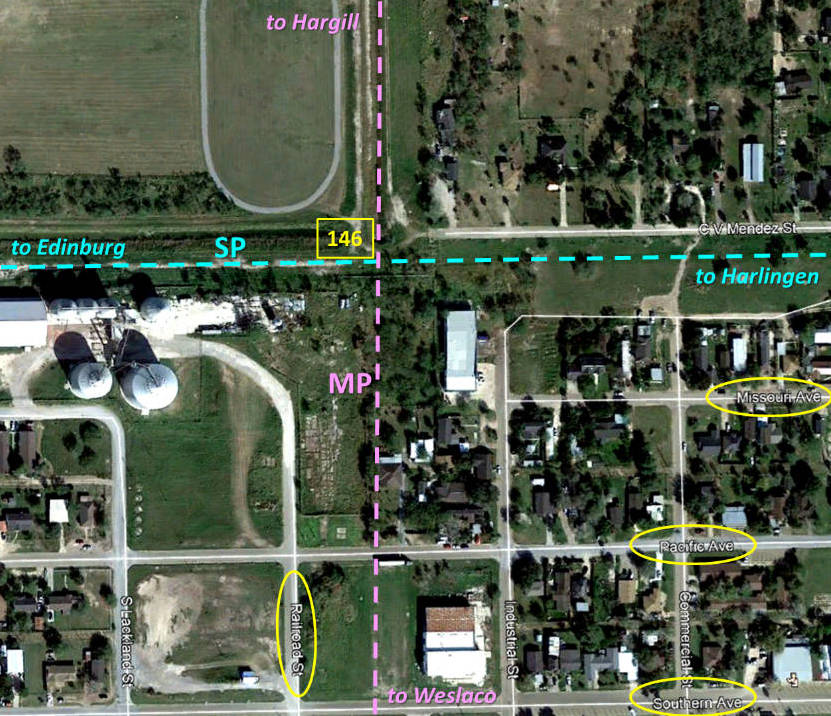
Above: While the rights-of-way
for the rail lines in Edcouch are at least vaguely apparent in Google Earth satellite
imagery, that is not the case on the ground, at least from Google Street View imagery. Other
than railroad-related street names (yellow ovals), there is very little physical
evidence that any railroad ever passed through Edcouch, let alone two of them.









